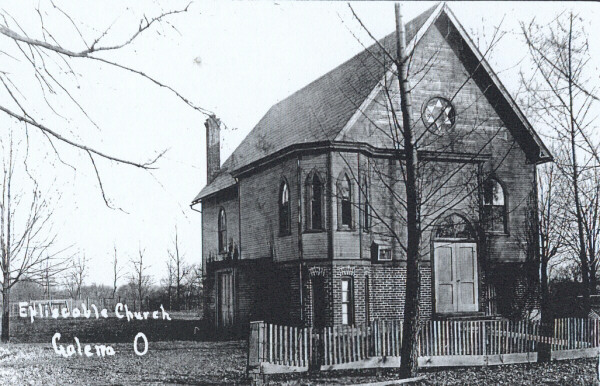| Because You Asked . . . . | ||||

|
||||
|
Our
Savior Episcopal Church, built in 1896, existed from 1877 until 1932 in Galena |
||||
|
Churches
Cooperate on Land Deal |
||||
|
Nails
marking property lot corners have recently been pounded into the pavement
of Church Street in Galena and wooden stakes have appeared in the parking
lot next to the administration building for the Big Walnut School
District. All this surveyors' activity is the result of a recent land
agreement between the United Methodists and the Episcopalians. When was an
Episcopal Church in Galena? Although
long forgotten today, the Episcopal faith dates back to the pioneer
settlement days in the Big Walnut area. The mother church for the area was
erected at Berkshire in the 1820s through the influence of Philander
Chase, Ohio's first and foremost Episcopal bishop, and is thought to have
been the second oldest Episcopal church in the state. But the most
impressive church of this denomination in the area stood in Galena for
half a century. This congregation began in 1875, and two years later they
built what was characterized in the 1880 Delaware County history as
"one of the handsomest brick edifices in the county." Located in
Galena on the corner of Walnut and Church Streets where a parking lot is
now located, it was built from the plans of a New Jersey architect and
cost $1,750. Named Our Savior Episcopal Church, it was considered a
mission congregation by the Diocese of Southern Ohio in Cincinnati that
had jurisdiction over central Ohio. By
the summer of 1895, the early Berkshire congregation had dwindled and all
the original families were gone, their farms sold to members of other
faiths. The Diocese decided to sell the Berkshire church and furniture and
use the proceeds to help support the Galena church. Along with this
financial Late
in October 1895, the Galena Episcopalians held nightly services in
preparation for a Confirmation Sunday that would be presided over by the bishop.
The plans came to naught when a fire started and completely destroyed the
roof and interior of the church. Thoughts of repair were quickly replaced
with the idea of a totally new building. The congregation had no
insurance, but the necessary funds were raised in very short order, and C.
A. Howell, an architect from Westerville, was hired to design a new
church. Construction began in the spring of 1896 and was completed that
year. Predominantly frame, the church had an elevated basement of brick
that housed a social hall and lecture rooms. The
new church served the Galena Episcopalians admirably for several decades.
But just as with the Berkshire group, family members gradually began to
die and the congregation's membership dropped off .By the 1920s, the
church stood vacant and in 1925, the adjacent school began to use it for
overflow classrooms
and the Methodists occupied it for Sunday School. Two years later , the
Diocese offered to sell it to the village board of education. While they debated
the purchase price, a woman from New York City who had grown up in Galena
and whose father had helped build the church, offered to buy the In
the meantime, the land was supposedly sold to George DeVore who operated a
funeral home across the street and needed it for parking. He, in turn, was
said to have donated the land and an adjacent lot to the school with the
understanding that the Methodists would have access to them for parking
during evening hours and on Sunday. Long-time residents in the village
recalled all these details, some established on the basis of gentlemen's
agreements. Unfortunately no one had ever thought to record these
transactions in the courthouse. At
the turn of the 21st century, as the Methodist congregation considers
expanding their building, investigation of the legal status of the parking
lot was necessary. At best, records were muddled. One office at the
courthouse listed the Episcopal church as still owning the end of the
parking lot. While the church archives in Cincinnati referenced the land
being sold to the New York woman, the deed itself had disappeared and no
legal record of the transaction could be found. Another county office even
showed the land belonging to the Methodists! To
clarify this legal uncertainty, the Episcopal Diocese agreed to deed the
land to the Methodists in exchange for lawyers' fees. Thanks to their
generous gift, the Big Walnut schools and the Galena United Methodist
Church have now begun discussions about jointly paving their mutual
parking lot. |
||||
|
. . . .And Now You
Know
|
||||
| Return to Local History Index |
(04/01/2006 ) |
|||